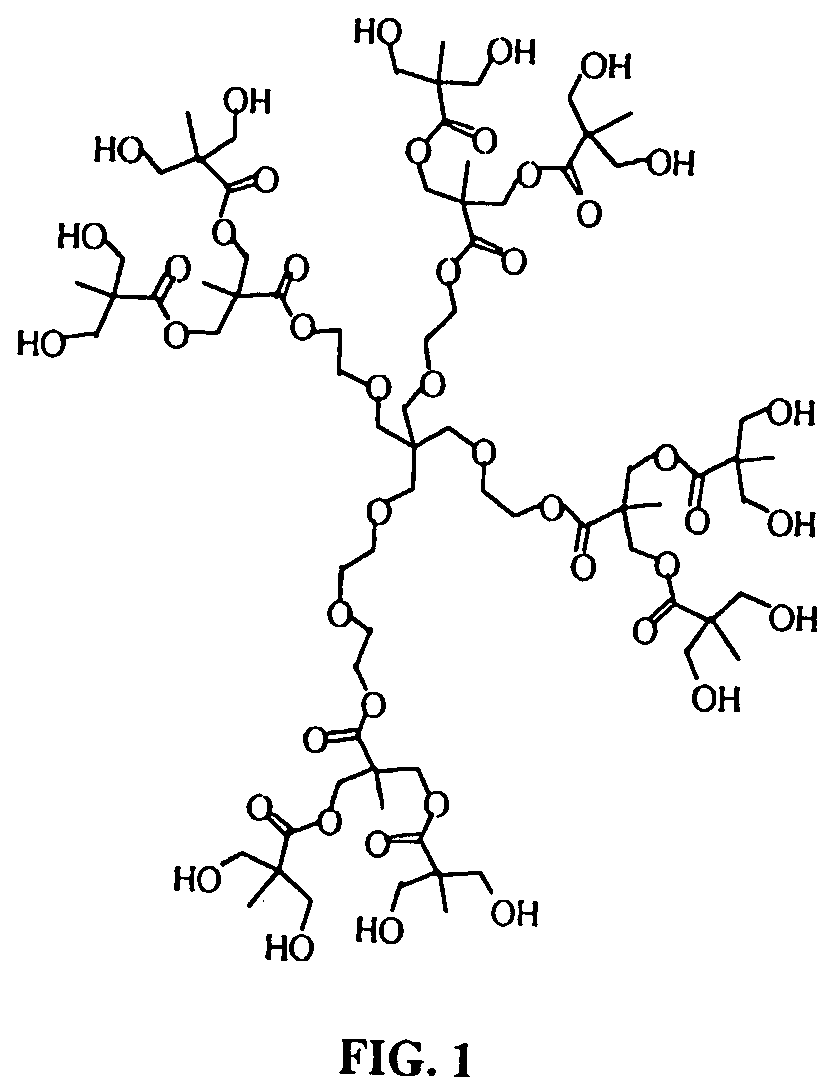Composites and methods for their production
- Summary
- Abstract
- Description
- Claims
- Application Information
AI Technical Summary
Benefits of technology
Problems solved by technology
Method used
Image
Examples
example 1
Method for Exfoliated and Intercalated Silicates in an HBP Matrix
The required weight fraction of sodium montmorillonite clay is mixed at about 50° C. with about 10 g of two, three or four pseudo-generation —OH terminated Boltorn™ HBP dispersed in 75 ml of deionized water, and the water left to evaporate in air under stirring with a magnetic stir bar at about 1 rotation per second. After evaporation of sufficient water to give a thixotropic gel, the gel is transferred to an open silicone rubber mould and dried in air at about 30 to 60° C. for a day. Drying is continued at about 80 to 140 CC under vacuum for a further two days. The resulting solids are ground, pressed into 25 mm diameter 1 mm thick disks at about 50 to 100° C. between poly imide sheets, using a hydraulic press, and stored in a dessicator. Wide angle X-ray scattering data for two and four pseudo-generation HBPs with different sodium montmorillonite contents prepared from aqueous dispersions are shown in FIG. 2. At t...
example 2
Method for Intercalated Layered Silicates in an HBP Matrix
The required weight fraction of sodium montmorillonite or organically modified sodium montmorillonite clay is mixed at about 50° C. with about 10 g of two, three or four pseudo-generation —OH terminated Boltorn™ HBP dispersed in 75 ml of tetrahydrofuran (THF). The THF is left to evaporate in air under stirring with a magnetic stir bar set to about 1 rotation per second. After evaporation of sufficient THF to give a thixotropic gel, the gel is transferred to an open silicone rubber mould and dried under vacuum at about 30 to 50° C. for a further two days. The resulting solids are ground, pressed into 25 mm diameter 1 mm thick disks at 50 to 100° C. between poly imide sheets, using a hydraulic press, and stored in a dessicator. With tetrahydrofuran as the solvent, intercalation is observed in HBP / sodium montmorillonite prepared in this way at all compositions investigated. This is illustrated in FIG. 3, in which nanocomposit...
example 3
Method for Exfoliated Layered Silicates in Cross-Linked HBP Matrix
Two, three or four pseudo-generation HBP / 10 wt % sodium montmorillonite, prepared from a dispersion in water as in Example 1, is carefully dried and re-dispersed in THF and mixed in solution with between about 20 and 50 wt % of an aromatic diisocyanate, diphenyl methyl diisocyanate (MDI). After evaporation of the THF at room temperature under vacuum, the system is cured at between 50 and 100° C. under vacuum to give a hydrophobic glassy amorphous solid at high MDI content or a rubbery solid at low MDI content. Wide angle X-ray scattering and transmission electron microscopy show the initial exfoliated state of the silicate layers to be maintained (FIG. 4). As shown in FIG. 5, the exfoliation of the sodium montmorillonite in the resulting composites leads to a significant increase in stiffness and an increase in ultimate tensile strength, even at relatively low montmorillonite contents. As also shown in FIG. 5, comp...
PUM
| Property | Measurement | Unit |
|---|---|---|
| Diameter | aaaaa | aaaaa |
| Reactivity | aaaaa | aaaaa |
| Thermoplasticity | aaaaa | aaaaa |
Abstract
Description
Claims
Application Information
 Login to View More
Login to View More - R&D
- Intellectual Property
- Life Sciences
- Materials
- Tech Scout
- Unparalleled Data Quality
- Higher Quality Content
- 60% Fewer Hallucinations
Browse by: Latest US Patents, China's latest patents, Technical Efficacy Thesaurus, Application Domain, Technology Topic, Popular Technical Reports.
© 2025 PatSnap. All rights reserved.Legal|Privacy policy|Modern Slavery Act Transparency Statement|Sitemap|About US| Contact US: help@patsnap.com



